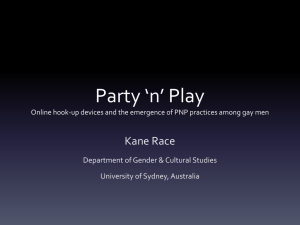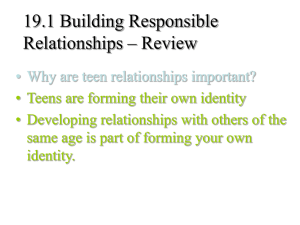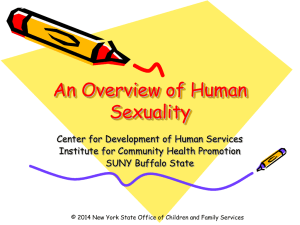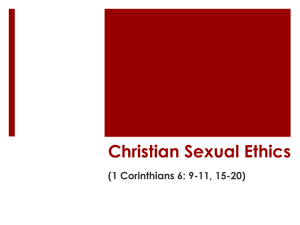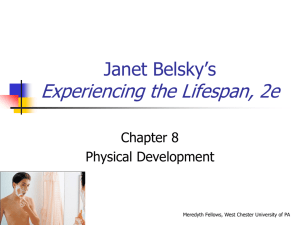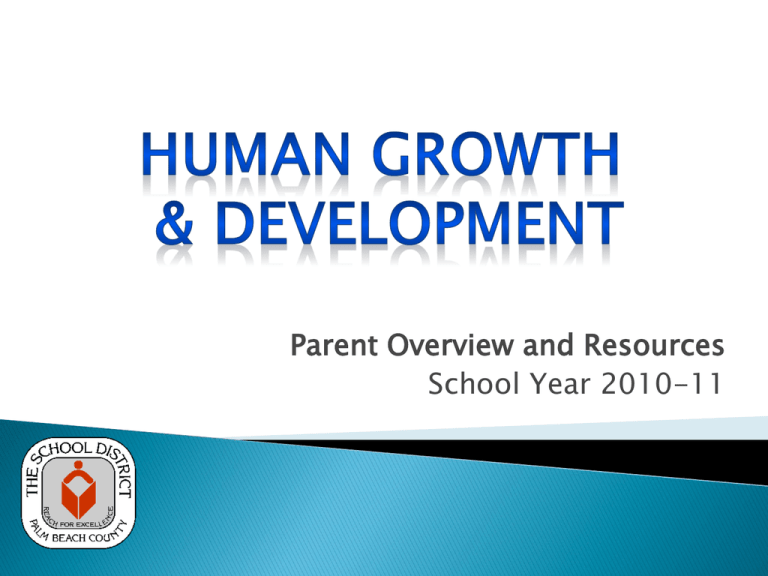
Parent Overview and Resources
School Year 2010-11
It is a matter of life and death.
Majority of adolescent HIV infections occur from sexual
transmission
About 15% of all new HIV infections occur among youth
ages 15-24
Most youth are unaware of risk; they may not know that
they may be infected
Fiscal impact is staggering.
Lifetime medical costs of STIs acquired by American youth
ages 15-24 in year 2000 will be at least $6.5 billion
Huge costs to future employers through insurance costs
and lost productivity
Annual cost of teen births is estimated at $8 billion
Palm Beach County is an “epicenter”
Palm Beach County reported 24.0 AIDS cases per
100,000 – the state rate was 21.7 per 100,000
(2009)a
Florida ranked 3rd (after NY & CA) among states that
reported HIV cases in 2007b
PBC, Miami-Dade and Broward have highest reported
numbers of HIV & AIDS cases in Florida for youth ages
13-25 - especially high for young African American
women and young men who have sex with men
aFlorida
Division of Disease Control Surveillance Report Jan 2010, No. 302 p. 7 & 10
http://www.doh.state.fl.us/Disease_ctrl/aids/trends/msr/2010/MSR0110.pdf
bHIV/AIDS Surveillance Report 2007, Vol. 19 p. 38
http://www.cdc.gov/hiv/topics/surveillance/resources/reports/2007report/pdf/2007SurveillanceReport.pdf
Rates are alarmingly high for teens!
Teens (Youth 10-19) in Florida (2008) accounted for
• 30% (29.7%)c of all gonorrhea cases
• 34% (34.3%)d of all chlamydia cases
PBC female teens (ages 15-19) account for 27% (941/3492=26.95%) of
chlamydia cases and 19% (195/1013=19.25%) of gonorrhea casese
four in ten (38.5%) sexually active teens do not use condomsf
youth do not perceive many of their sexual
behaviors as putting them at riskg
c
http://www.doh.state.fl.us/disease_ctrl/std/trends/florida/Gostate.pdf
d
http://www.doh.state.fl.us/disease_ctrl/std/trends/florida/Chstate.pdf
e
http://www.doh.state.fl.us/disease_ctrl/std/trends/florida.html
f
2007 Youth Risk Behavior Survey http://www.cdc.gov/HealthyYouth/yrbs/pdf/yrbs07_us_overview.pdf
g
Many sources, incl. Office of National AIDS Policy http://clinton5.nara.gov/ONAP/youth/youth4.html
Chlamydia is the leading preventable cause of infertility in the U.S.
• Teens and young adults have highest rates of infection; one in ten
adolescent females test positive.
• 70% of women and 50% of men have asymptomatic infections
and frequently go undiagnosed.
• A urine test detects Chlamydia. Antibiotics cure it.
• Untreated, can lead to pelvic inflammatory disease (PID), pregnancy
complications, newborn infections, and infertility.
• Annual screening recommended for all sexually active females less
than 25 years of age. (U.S. Preventive Services Task Force, 2007)
HIV:
◦ Palm Beach County (rate)…………..26.4 (FL – 40.3)
◦ Palm Beach County (count)…………340
AIDS:
◦ Palm Beach County (rate)…………..24.3 (FL – 26.3)
◦ Palm Beach County (count)…………313
Source: Florida Division of Disease Control Surveillance Report Jan 2010, No. 302 p. 7 & 10
http://www.doh.state.fl.us/Disease_ctrl/aids/trends/msr/2010/MSR0110.pdf
STIs - Counts (Rate per 100,000):
◦ Chlamydia (15-19)…………….1,135 (1450.1)
Rates in middle school students are on the rise.
◦ Gonorrhea (15-19)…………….291 (371.8)
◦ Infectious Syphilis (All)…………………….9 (11.5)
◦ Total Gonorrhea/Chlamydia/Syphilis (15-19)…1,435 (1833.4)
Source: http://www.doh.state.fl.us/disease_ctrl/std/trends/florida.html
CASES
180
160
140
120
100
80
60
40
20
0
<5
5 TO 12
13 TO 19
20 TO 29
30 TO 39
40 TO 49
> 49
1999
2000
2001
2002
YEAR OF REPORT
2003
Sweden
France
Females
Males
Canada
Great Britain
(16-19)
United States
0
20
40
60
80
100
% of 18-19-year-olds who had two or more partners
AGI
Note: Data for mid-1990s.
Teenage Sexual and Reproductive Behavior in Developed Countries, 2001.
A sexually active teenager who is not using
contraception has a 90% chance of becoming pregnant
within a year.h
Teen birth rates may be down, but still unacceptable;
more than ¾ (82%) of teen pregnancies are unintended.i
Repeat teen births remain problematic, in 2007:
◦
◦
◦
◦
Palm Beach County had 20.5% repeat births
Broward had 16.9%
Miami-Dade had 17.0%
The state rate was 18.4% j
Teen moms are more likely to drop out of school and
live in poverty; their children face multiple increased
risks.
h
Alan Guttenmacher Institute http://www.guttmacher.org/pubs/FB-ATSRH.html
i
Alan Guttenmacher Institute http://www.guttmacher.org/pubs/FB-ATSRH.html
j
Florida CHARTS (2008)
Births per 1,000 women 15-19
100
80
United States
England and Wales
Canada
France
Sweden
60
40
20
0
1970
1975
1980
1985
1990
1995
2000*
*Data are for 1997 in Canada, 1998 in France and 1999 in England and Wales and Sweden.
AGI
Teenage Sexual and Reproductive Behavior in Developed Countries, 2001.
Live births in Palm Beach County:
◦
◦
◦
◦
0-14………………………………………..…..22 (2008)
15-17……………………………………...…452 (2008)
18-19…………………………………………886 (2008)
15-19 Repeat births……………………….276 (2006-08)
Source: Florida CHARTS (2008)
Almost 9 in 10 parents want their children
to have it.
23 states mandate it and 13 others
encourage its teaching.
Over 90 national organizations believe that
all children and youth should receive it.
Yet, only 5% of children in America receive
it.
“It” is comprehensive sexuality education.
The School District of PBC conducts the YRBS
every two years in Grades 7 & 8 and high school.
Random selection through 2nd period classes.
The surveys are anonymous and self-reported.
Weighted data (meaning that results can be
generalized to make assumptions about all
students in PBC) have been obtained every year
since 1999.
Question categories include:
◦
◦
◦
◦
◦
◦
◦
Injury and Violence
Tobacco Use
Alcohol and Other Drug Use
Sexual Behaviors
Weight Management and Dietary Behaviors
Physical Activity
Other
Answers are disaggregated by:
◦
◦
◦
◦
Gender
Age
Grade
Race/Ethnicity
Sexually Active
◦ 54.7% of high school youth were sexually active, up from
47.3% in 2001.
◦ 21.9% of middle school youth were sexually active.
Early Initiation
◦ 8.3% of high school youth had sexual intercourse before
the age of 13 years.
◦ 6.3% of middle school youth had sexual intercourse before
the age of 11 years.
Multiple Partners
◦ 18.2% of high school youth had sexual intercourse with 4
or more different partners.
◦ 9.7% of middle school youth had sexual intercourse with 3
or more different partners.
Source: CDC-DASH (2009)
Percentage of HS students who ever had sexual intercourse
56.0
54.0
52.9
54.7
Percentage
52.0
51.3
50.0
48.0
50.0
47.3
46.0
44.0
47.8
42.0
1999
2001
2003
2005
YRBS Year
2007
2009
Percentage of HS students who had sexual intercourse
before age 13 years
12.0
11.2
Percentage
10.0
9.2
8.0
9.5
8.3
6.0
6.9
4.0
6.5
2.0
0.0
1999
2001
2003
2005
YRBS Year
2007
2009
Percentage of HS students who had sexual intercourse
with 4 or more partners
20.0
19.7
16.8
18.2
Percentage
15.0
14.6
10.0
13.5
14.4
5.0
0.0
1999
2001
2003
2005
YRBS Year
2007
2009
Percentage of HS students who had sexual intercourse
in the past 3 months (i.e., are currently sexually active)
40.0
38.2
39.0
35.0
38.3
30.0
32.1
34.7
25.0
35.6
20.0
15.0
10.0
5.0
0.0
1999
2001
2003
2005
2007
2009
Percentage of HS students who used
alcohol or drugs before last sexual intercourse
30.0
26.1
24.2
Percentage
25.0
25.5
20.0
24.3
15.0
21.1
17.7
10.0
5.0
0.0
1999
2001
2003
2005
YRBS Year
2007
2009
Among HS students who had sexual intercourse, the
percentage who
used a condom during last sexual intercourse
72.0
71.2
Percentage
70.0
68.0
66.1
66.0
68.5
67.3
64.0
68.2
62.6
62.0
60.0
58.0
1999
2001
2003
2005
YRBS Year
2007
2009
Among HS students who had sexual intercourse, the
percentage who used birth control pills to prevent pregnancy
before last sexual intercourse
16.0
15.5
14.0
15.1
14.9
14.6
16.0
Percentage
12.0
13.0
10.0
8.0
6.0
4.0
2.0
0.0
1999
2001
2003
2005
YRBS Year
2007
2009
Percentage of HS students who had been
taught about HIV/AIDS in school
88.0
87.5
87.5
Percentage
87.0
87.6
86.7
86.5
86.0
85.5
85.9
85.9
85.0
85.6
84.5
1999
2001
2003
2005
YRBS Year
2007
2009
Percentage of MS students who ever had sexual intercourse
26.0
25.0
25.6
25.4
25.0
Percentage
24.0
23.0
22.0
21.0
21.5
21.9
20.0
21.4
19.0
1999
2001
2003
2005
YRBS Year
2007
2009
Percentage of MS students who had sexual intercourse
before age 11 years
7.5
7.5
Percentage
7.0
7.1
6.7
6.8
6.5
6.8
6.0
6.3
5.5
1999
2001
2003
2005
YRBS Year
2007
2009
Percentage of MS students who had sexual intercourse
with 3 or more partners
12.0
Percentage
10.0
11.0
8.8
9.9
8.0
10.1
6.0
9.7
6.9
4.0
2.0
0.0
1999
2001
2003
2005
YRBS Year
2007
2009
Among MS students who had sexual intercourse, the
percentage who used a condom during last sexual
intercourse
78.0
76.2
Percentage
76.0
74.0
72.0
76.7
74.1
72.6
70.0
70.9
68.0
70.3
66.0
1999
2001
2003
2005
YRBS Year
2007
2009
Percent of MS students who had been taught about HIV/AIDS
in school
90.0
80.0
Percentage
70.0
77.3
76.5
60.0
86.5
76.4
76.5
50.0
71.1
40.0
30.0
20.0
10.0
0.0
1999
2001
2003
2005
YRBS Year
2007
2009
Focus: building online communities of
people who share interests and activities.
Most SNS are web-based.
Encourage new ways to communicate
and share information.
Used regularly by millions of people.
Statements, pictures, and videos that are posted
may have consequences and may survive “deletion”
for others to see, including friends, strangers,
employers, etc.
Teens have revealed passwords that have allowed
their pages to be commandeered by others.
With cutting & pasting, it is easy to create a page
and contact friends.
This can lead to a false perception of a teen’s
involvement in risky behavior, and reveal name,
address, phone number, etc.
Sometimes, the results can be much worse…
In October 2006, 13-year-old Megan
Meier from Dardenne Prairie, MO
committed suicide after the mother
of a former friend of Megan’s
allegedly created a fictitious profile
(“Josh Evans”) on MySpace in order to
gain Megan’s trust and learn what
Megan was saying about her
daughter. This “cyber-bullying”
allegedly included the final post, “The
world would be a better place
without you,” contributing to Megan
hanging herself 3 weeks prior to her
14th birthday (Megan Meier
Foundation, 2009).
Before teens hit “send,” they (and their parents/
guardians) should consider the following:
20% OF TEENS HAVE SENT ELECTRONICALLY, OR
POSTED ONLINE, NUDE OR SEMI-NUDE
PICTURES OR VIDEO OF THEMSELVES.
Your messages and images will get passed
around, even if you think they won’t:
◦ 40% of teens and young adults say they have had a
sexually suggestive message (originally meant to be
private) shown to them, and
◦ 20% say they have shared such a message with
someone other than the person for whom it was
originally meant.
Something that seems fun and flirty and is done on a
whim will never really go away.
Potential employers, college recruiters, teachers,
coaches, parents, friends, enemies, strangers and
others may all be able to find your past posts, even
after you delete them.
And it is nearly impossible to control what other people
are posting about you.
Think about it: Even if you have second thoughts and
delete a racy photo, there is no telling who has already
copied that photo and posted it elsewhere.
More than 40% of teens and young adults (42%
total, 47% of teens, 38% of young adults) say
“pressure from guys” is a reason girls and women
send and post sexually suggestive messages and
images.
More than 20% of teens and young adults (22%
total, 24% teens, 20% young adults) say “pressure
from friends” is a reason guys send and post
sexually suggestive messages and images.
Just because a message is meant to be fun
doesn’t mean the person who gets it will see it
that way.
◦ Four in ten teen girls who have sent sexually
suggestive content did so “as a joke,” but
◦ Many teen boys (29%) agree that girls who send such
content are “expected to date or hook up in real life.”
It’s easier to be more provocative or outgoing
online, but whatever you write, post or send
does contribute to the real-life impression
you’re making.
Nearly one in five young people who send
sexually suggestive messages and images, do
so to people they only know online (18% total,
15% teens, 19% young adults).
It is important to remember that even if
someone only knows you by screen name,
online profile, phone number, or e-mail
address, they can probably find you if they try
hard enough.
Source: The Campaign to Prevent Teen Pregnancy:
http://www.thenationalcampaign.org/sextech/PDF/5_Things.pdf
In July 2008, Jesse Logan, an
18-year-old senior from
Cincinnati, Ohio, committed
suicide following the
distribution of photographs
she sent to a boyfriend and he
subsequently forwarded to
other classmates. The
perceptions and stigma she
received from other students
contributed to her decision to
take her life (MSNBC, 2009).
In September 2009, Hope
Witsell, a 13-year-old eighth
grader from Ruskin, FL (near
Tampa), committed suicide. She
had sent a nude photo of herself
to a boy she liked, and another
girl used his phone to send the
picture to other students who
forwarded it along. The
relentless taunting she received
from other students contributed
to her decision to hang herself
(St. Petersburg Times, 2009).
Originally created by Science Department Staff, CDC
Grant Staff, and Health Services Specialist, with PBC
Health Department and community input.
Currently taught in Grades Kindergarten through 9.
Additionally, there is a 10th Grade Biology lesson.
Curriculum is linked to Next Generation Standards,
is science-based, and content-appropriate for the
grade level.
Taught through the classroom teacher in elementary
school grades and through Science Teacher in
middle and high school grades.
Traditional and electronic staff development training
is provided to instructors.
The Human Growth & Development Curriculum is
a choice, not a requirement.
Parent(s)/guardian(s) have the choice to opt their
child out of the curriculum.
Students who’s parent/guardian has opted them
out of the curriculum will be given alternative
assignments to complete during the 5 day course
of the curriculum.
Opt-out letter will come home with students and,
if the parent/guardian chooses to opt their child
out, the letter must be returned indicating the
parent does not want the child to participate.
Major components:
◦
◦
◦
◦
Amber Watch
Too Good For Drugs
Character Education
Education on Germs
Major components:
◦ Amber Watch
◦ Too Good For Drugs
◦ Character Education
plus…
◦ Basic HIV information
Bloodbourne transmission
Not transmitted through casual contact
Compassion for those who are living with HIV/AIDS
◦ Grades 4 and 5 lessons discusses puberty
Classes are segregated by gender
Age appropriate content
Major components:
◦ Decision-making, peer
pressure, refusal skills, media
influences
◦ Human Reproduction
◦ Contraception
Note: The School District does not
authorize a “condom demonstration”
◦ STI Prevention Education
◦ HIV/AIDS Prevention Education
Major components:
◦ Decision-making, media
influences
◦ Human Reproduction
◦ Contraception
Note: The School District does not
authorize a “condom demonstration”
◦ STI Prevention Education
◦ HIV/AIDS Prevention Education
Students participate in an activity
demonstrating how HIV may be
transmitted (Photo: Palm Beach Post).
Grade 10 lesson utilizes the
Palm Beach Post’s Newspapers
In Education (NIE) program.
Originally written in 2000 by
our Science Department.
Its focus is more virological
than behavioral.
Updated annually.
Major components:
◦
◦
◦
◦
HIV/AIDS Virology
History of the Virus
Florida Statistics
Virus/Vaccine Researchers
Science teachers participate in professional
development each year in March/April.
District Science Department provides teacher
training.
Teachers receive continuing education units
toward their recertification.
Teachers may also be trained through Adobe
Presenter (Train U).
Follow up is provided by science and CDC Staff.
Palm Beach County is the only LEA that has such detailed follow up
analysis, ensuring that as many students as possible participate in the
curriculum.
“But they’re just children!”
“Not my kids. I know what they’re thinking.”
“Do I have to talk to them about THAT?”
“I’m concerned how my child will view me.”
“What if I can’t answer all their questions?”
Source:
Start at age 10 or 11, before your child begins
puberty.
Use bite-sized pieces of information – build on
information over time.
Use movies, TV or everyday occurrences as
“ways into” the conversation.
Use child/parent activities as a forum for brief
conversations.
Share your values and expectations; you don’t
have to use explicit language.
Avoid confrontation – there’s no need to have
“the big talk” all at once.
Ask questions.
Don’t judge or criticize.
Invite ongoing dialogue.
Keep it casual and light.
Recommended DVD: “Sex and the Silent Parent”
Available from Connect with Kids website:
http://www.connectwithkids.com/products/sex_silent_parent.shtml
211 Hotline @ 211 or www.211.org
211 Youth Yellow Pages
Centers for Disease Control and Prevention @
www.cdc.gov
Guidance Counselor
School Administrator
School Nurse
Science/Classroom
Teacher
Parents/guardians may review the Human
Growth and Development curriculum at your
child’s school.
For questions about the Human Growth &
Development curriculum, contact your school
administration or Wendy Spielman, K-12
Science Manager, at spielw@palmbeach.k12.fl.us.

